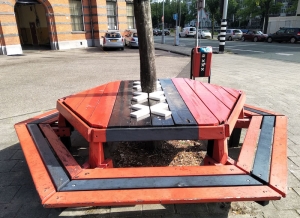Dating back to the early 16th centruy, Amsterdam has always been tolerant of minorities, first of all in religious matters. The founding fathers of the Dutch nation proclaimed ‘freedom of conscience’ during the rebellion against the Spanish king, which not only applied to the protestants, but to the Jewish refugees from Portugal as well. Hence, Amsterdam housed the largest Jewish community in Europe, and the only one where the people could pick up the religion, culture, and surnames of their ancestors, and live wherever they pleased.
Also, the city provided a safe haven for French protestants, known as Huguenots, for Mennonites, remonstrants, and along the canals a mosque, an Armenian church, a Greek church, and all kind of chapels were erected, much to the astonishment of British visitors.
The prominent Jewish philosopher Spinoza was ousted by his own community for his belief that church and state should be separated, but other persecuted philosophers found their way to ’the most liberal city in the world’, as New York historian Russell Shorto would have it. He expressly attributed the Golden Age wealth to this typical tolerance, often called indifference.
René Descarted fled France, John Locke fled restoration Britain, Moravian philosopher Jan Amos Comenius found refuge here, among others. And John Adams lived in Europe’s first American consulate, to gather support from Amserdam bankers for the American revolution.
In the 1960s, Amsterdam quickly became a world center for ‘counter culture’. Known internationally as ‘Magic City’, it attracted many youths who wanted to indulge in the pleasures of freedom and drugs.
Already in the 1920s, there were bars where same sex couples could dance intimately – but no kissing -, and during the 1970s many gay men and women celebrated their freedom in Amsterdam. So it came as no surprise that in 2001, mayor Job Cohen concluded the world’s first same-sex marriage.
Enjoy a tour of freedom in the town center, past many places that welcomed birds of so many feathers.



